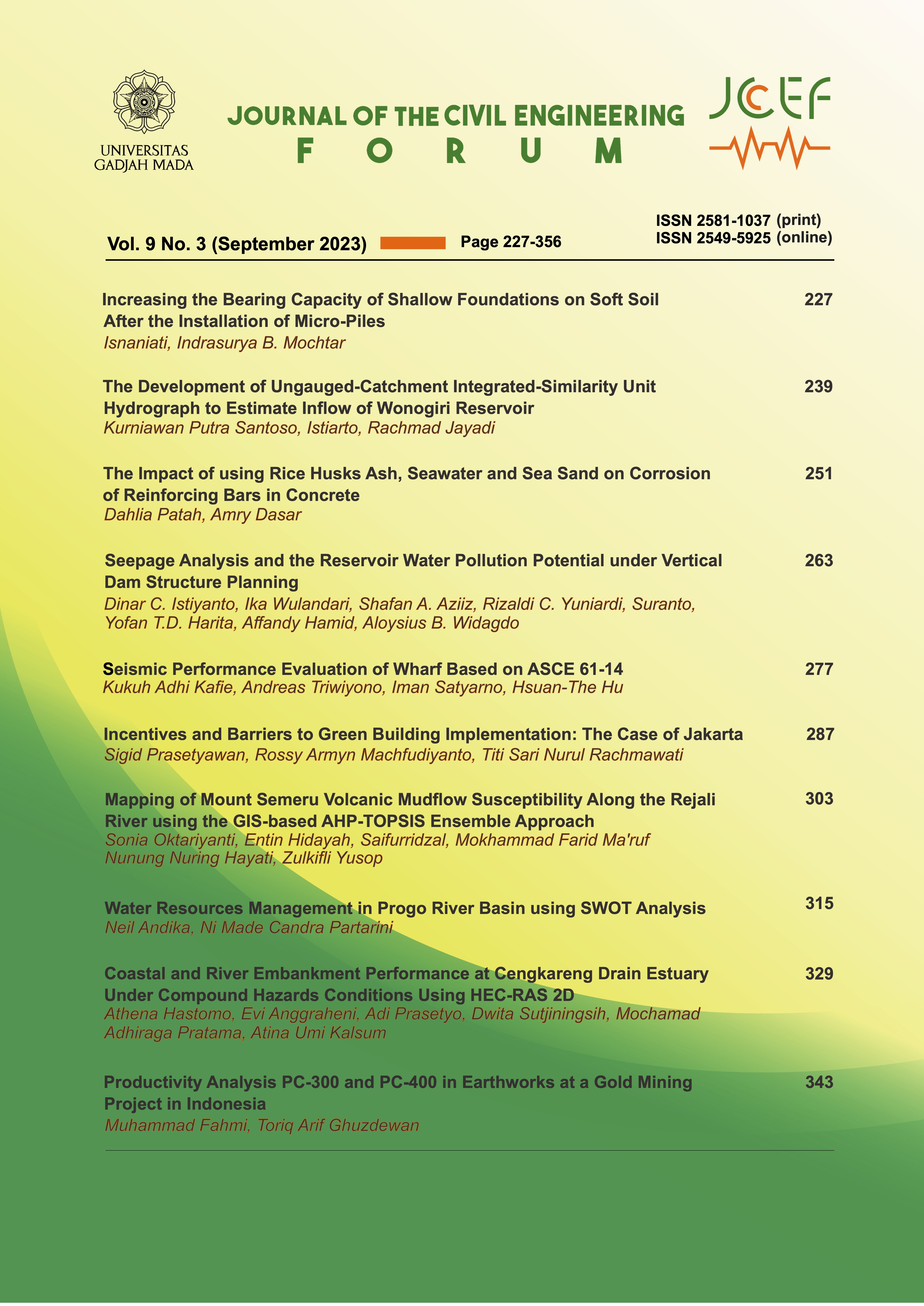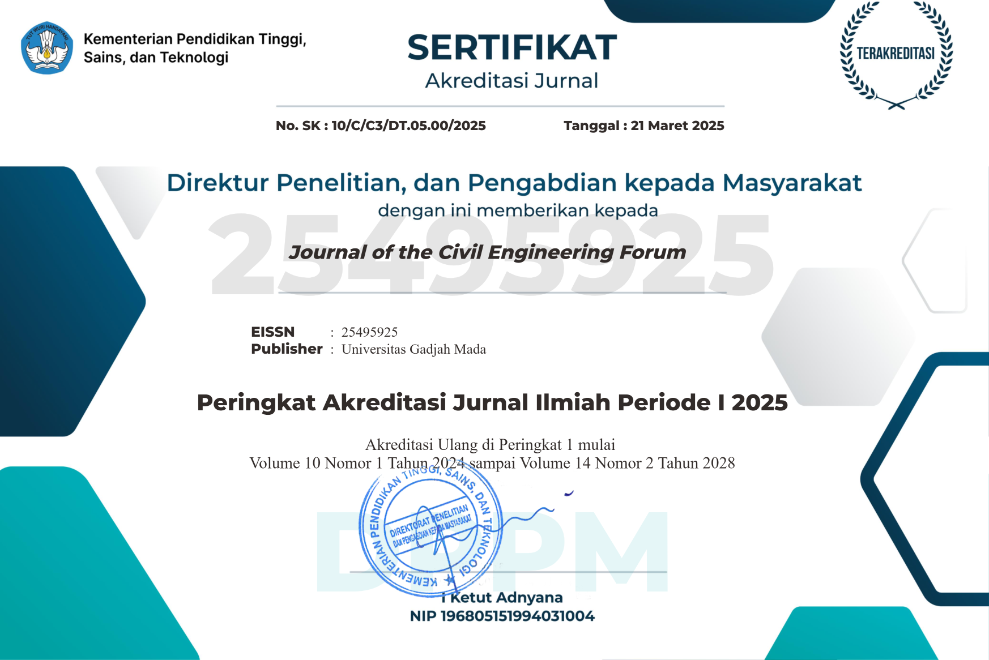Seismic Performance Evaluation of Wharf Based on ASCE 61-14
Abstract
The adequacy of the structural performance of a wharf in withstanding seismic loads is of paramount importance. Therefore, this research aims to conduct an accurate pushover analysis on the adequacy of a wharf located in North Sulawesi, Indonesia. The study provides a comprehensive overview of the seismic performance of the wharf by examining displacement and strain parameters of its plastic hinge components under various loading conditions. To simulate accidental torsion, the wharf structure was analyzed by introducing variations in the eccentricity offset of the lateral pushover load of -5%, 0%, and 5% from the center of mass. The analysis of the torsion behavior involved a comprehensive examination of four control points located at each corner of the wharf plan. Additionally, the investigation took into account, the crucial aspect of soil-structure interaction by considering the equivalent fixity depth of the pile, which was used to evaluate the fixity length of the structure. In order to determine the target displacement of the wharf, analysis was performed in accordance with the established methodologies outlined in FEMA 356. It is also important to note that the seismic performance of the wharf was evaluated based on acceptance criteria in the form of strain limits imposed on various components, including concrete elements, reinforcing steel, and steel pipes, as prescribed by ASCE 61-14. In this study, a total of 30 models were examined, and the obtained results showed that the structure exhibited controlled and repairable damage even when subjected to a 475-year earthquake return period (CLE: Contingency Level Earthquake). Following this, the analysis of variations in displacement control point served to determine the inherent torsion exhibited by the structure, and the introduction of different lateral load eccentricity offsets and variations in pushover loading direction were found to contribute to the increased displacement and strain in the plastic hinge components.
References
Applied Technology Council, ATC-40 (1996), ATC 40: Seismic Evaluation and Retrofit of Concrete Buildings, Seismic Safety Commission, California: ATC.
ASCE (2014), ASCE 61-14: Seismic Design of Piers and Wharves, ASCE, California.
ASCE 7 (2010), Minimum Design Loads for Buildings and Other Structures, 7th–10th edn, ASCE, Virginia.
ASCE 7 (2016), Minimum Design Loads for Buildings and Other Structures, 7th–16th edn, ASCE, Virginia.
ASCE 7 (2022), Minimum Design Loads for Buildings and Other Structures, 7th–22nd edn, ASCE, Virginia.
Bergman, A. W., Story, S. M., Howard, T. A. and Lighty, T. A. (2016), Seismic Design of an Irregular Wharf Utilizing ASCE 61, in ‘Ports 2016’, pp. 273–282.
Bruin, W., Goel, R. and Galbraith, J. (2016), Comparison of Procedures for Computing Seismic Displacement Demand for Concrete Piers and Wharf Structures, in ‘Ports 2016’, pp. 567–576.
FEMA (2011), ‘FEMA P-55, Coastal construction manual: Principles and practices of planning, siting, designing, constructing, and maintaining residential buildings in coastal areas’.
FEMA, P. (2000), ‘Commentary for the seismic rehabilitation of building, FEMA-356, Federal Emergency Management Agency’, Washington, DC .
Goel, R. and Goel, H. (2017), Convergence behavior of substitute structure method in MOTEMS, in ‘Proceedings of the 16th World Conference on Earthquake Engineering Paper’, number 0350, pp. 9–13.
Goel, R. K. (2018), ‘Evaluation of a substitute structure method to estimate seismic displacement demand in piers and wharves’, Earthquake Spectra 34(2), 759–772.
Hanifah, Y., Budipriyanto, A. and Rahardjo, I. (2017), Seismic Performance Evaluation of A Pile supported pier in Aceh, Indonesia, in ‘IOP Conference Series: Materials Science and Engineering’, Vol. 267, IOP Publishing, p. 012022.
Nasional, B. S. (2019), ‘SNI 1726:2019 Tata Cara Perencanaan Ketahanan Gempa untuk Struktur Bangunan Gedung dan Nongedung’.
Palma-ochoa, M. and Vasquez, L. (2019), Performance-based seismic assessment for pile-supported wharves – A case Study, in ‘12th Canadian Conference on Earthquake Engineering’, pp. 1–8.
POLB (2012), ‘Port of Long Beach Wharf Design Criteria Version 3.0’, California.
POLB (2015), ‘Port of Long Beach Wharf Design Criteria Version 4.0’, California.
POLB (2021), ‘Port of Long Beach Wharf Design Criteria Version 5.0’, California.
Sandoval, J. D., Smith-Pardo, J. P. and Reyes, J. C. (2019), Evaluation of ASCE 61-14 Nonlinear Static Procedures for Estimating the Seismic Response of Wharves, in ‘15th Triennial International Conference’, American Society of Civil Engineers Reston, VA, pp. 175–184.
Su, L., Wan, H., Lu, J., Ling, X., Elgamal, A. and Arulmoli, A. (2021), ‘Seismic Performance Evaluation of A Pile-Supported Wharf System At Two Seismic Hazard Levels’, Ocean Engineering 219(November 2020), 108333. URL: https://doi.org/10.1016/j.oceaneng.2020.108333
Terzaghi, K. (1955), ‘Evaluation of coefficient of subgrade reaction, Geotechnique, Institution of Civ’.
The Overseas Coastal Area Development Institute of Japan, OCDI (2009), Technical Standards and Commentaries for Port and Harbour Facilities in Japan, The Overseas Coastal Area Development Institute of Japan, Tokyo.
Venkatalakshmi, P., Sree, J. and Rao, P. V. (2017), ‘Performance Based Design of Jetties’, International Journal of Innovative Research in Science, Engineering and Technology 6(8).
Zacchei, E., Lyra, P. H. and Stucchi, F. R. (2019), ‘Nonlinear static analysis of a pile-supported wharf’, Revista IBRACON de Estruturas e Materiais 12, 998–1009.
Copyright (c) 2023 The Author(s)

This work is licensed under a Creative Commons Attribution-ShareAlike 4.0 International License.
Copyright is granted to authors for the purpose of providing protection for articles written to describe experiments and their results. JCEF will protect and defend the work and reputation of the author and are also willing to address any allegations of violation, plagiarism, fraud, etc. against articles written and published by JCEF. JCEF is published under the terms of the Creative Commons Attribution-ShareAlike 4.0 International License (CC BY-SA 4.0). The author holds the copyright and assigns the journal rights to the first publication (online and print) of the work simultaneously.







